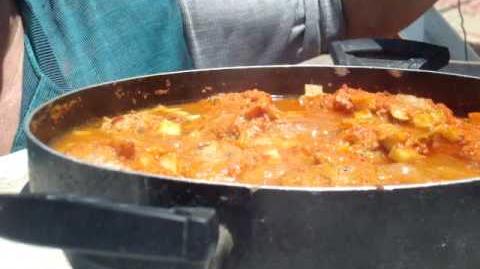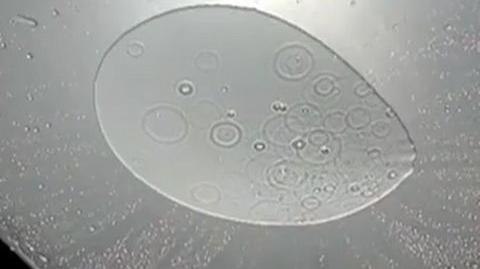No edit summary |
Tom Sponheim (talk | contribs) Tag: sourceedit |
||
| (16 intermediate revisions by 3 users not shown) | |||
| Line 1: | Line 1: | ||
| + | {{GoogleTranslateLinks}} |
||
| + | {{Updated|11|2|15}} |
||
| + | [[File:SolSource_Solar_Stove_with_Cookware.gif|thumb|right|300px|[[SolSource]], a consumer parabolic solar cooker]] |
||
| + | [[File:Shirdi roof collector array.jpg|thumb|right|300px|An array of[[Scheffler Community Kitchen|Scheffler parbolic cookers]] installed on the Shirdi Saibaba temple in Shirdi, {{State|Maharashtra}}, [[India]]]] |
||
| + | '''Parabolic solar cookers''' use a parabolic-shaped reflector to direct sunlight to a small area in order to generate heat for cooking. They are able to reach high temperatures, {{Degree|350}}, which allows them to be used for grilling and frying. These temperatures are significantly higher than what can be reached by a [[solar box cookers]] or [[solar panel cookers]] and allow the cooking times on a parabolic cooker to be comparable to a conventional stove, such as an electrical or gas burner. |
||
| + | The amount of food being cooked and the way in which the heat is used is generally dictated by the size of parabolic dish. Smaller dishes, which are generally around one meter in diameter, are intended to heat a traditional size pot or pan much like how you would cook on a traditional cooktop. The larger dishes, which can be as wide as five meters in diameter, are generally not used to heat a pot or pan directly, but instead are used to create steam by directing sunlight onto pipes carrying water. The steam is directed to cooking surfaces in a kitchen and is regulated by valves in order to offer control to the chef. |
||
| − | The amazing solar cooker "SOLARIO COOKER" designed by FOCALIS.net |
||
| + | ==Advantages and disadvantages== |
||
| − | [[File:Four solaire révolutionnaire SOLARIO COOKER de chez FOCALIS|thumb|right|335 px]] |
||
| + | '''Advantages''' |
||
| + | *Cooking times are similar to a traditional stovetop |
||
| + | *High temperatures allow for food to be fried and grilled |
||
| + | '''Disadvantages''' |
||
| − | [[File:Four_solaire_Solario.jpg]] |
||
| + | *Requires periodic adjustment to refocus it as the sun moves or a mechanical [[solar tracking]] apparatus |
||
| + | *Generally more expensive than panel and box cookers |
||
| + | |||
| + | ==What can you cook?== |
||
| + | Parabolic solar cookers generally operate at very high temperatures so they are ideal for frying, grilling, and boiling food. While they don't offer slow-cooking capabilities, they can be paired with a [[Heat-retention cooking|retained-heat cooker]] to prepare foods which call for longer cooking times at lower temperatures, such [[rice]], [[beans]] and many other [[foods]]. |
||
| + | |||
| + | :'''See also:''' [[Media:Parabolic solar cookbook - Imma Seifert.pdf|A cookbook showing how to cook in a parabolic cooker]] - ''[[Imma Seifert]]'' |
||
| + | |||
| + | ==Types of parabolic solar cookers== |
||
| + | ===Personal=== |
||
| + | If you’re interested in a parabolic solar cooker for personal use, a ~1 meter dish is an excellent choice. This size will allow you to cook for yourself and a small group of friends and family and can accommodate a larger group if simple technologies like [[heat-retention cooking]] are used to maximize the cooking power of the parabolic oven. A 1 meter dish is similar in size to a traditional barbeque so storage should not be too difficult. |
||
| + | |||
| + | ====Examples of personal parabolic cookers==== |
||
| + | *[[SolSource]] |
||
| + | *[[SK14]] |
||
| + | *[[Community Solar Cooker 3 SQ MT]] |
||
| + | |||
| + | ===Institutional=== |
||
| + | {{Main|Institutional solar cooking}} |
||
| + | Parabolic cookers offer advantages to box and panel cookers for individual consumers, but the technology is also well-suited to larger ovens on an institutional scale. Used slightly differently, larger parabolic cookers, which can reach up to five meters in diameter, are often used to focus sunlight on pipes carrying water. Rather than using the resulting heat to directly cook food, the heat turns the water into steam which is piped into a kitchen to heat a cooking surface. The steam is usually controlled by a valve in order to regulate heat during cooking. |
||
| + | |||
| + | ====Examples of parabolic institutional cookers==== |
||
| + | *[[Scheffler Community Kitchen]] |
||
| + | *[[Auroville Solar Kitchen]] |
||
| + | |||
| + | ==A simple way to draw a parabola== |
||
| + | {{NewNov15}}[[File:Simple_way_to_draw_a_parabola_-_Bernard_Mueller_2015.gif|none|675px]] |
||
| + | ==All parabolic solar cooker designs== |
||
| + | *Parabolic solar cooker designs are listed below along with a photographic directory to research individual cookers. |
||
[[Category:Solar cooker designs]] |
[[Category:Solar cooker designs]] |
||
[[Category:Solar calculations]] |
[[Category:Solar calculations]] |
||
Revision as of 20:46, 7 November 2015
|
Last edited: 2 November 2015
|
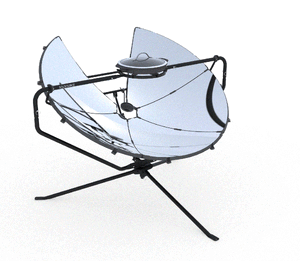
SolSource, a consumer parabolic solar cooker
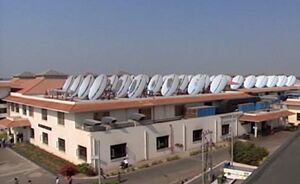
An array ofScheffler parbolic cookers installed on the Shirdi Saibaba temple in Shirdi, Maharashtra, India
Parabolic solar cookers use a parabolic-shaped reflector to direct sunlight to a small area in order to generate heat for cooking. They are able to reach high temperatures, 350 °C (662 °F), which allows them to be used for grilling and frying. These temperatures are significantly higher than what can be reached by a solar box cookers or solar panel cookers and allow the cooking times on a parabolic cooker to be comparable to a conventional stove, such as an electrical or gas burner.
The amount of food being cooked and the way in which the heat is used is generally dictated by the size of parabolic dish. Smaller dishes, which are generally around one meter in diameter, are intended to heat a traditional size pot or pan much like how you would cook on a traditional cooktop. The larger dishes, which can be as wide as five meters in diameter, are generally not used to heat a pot or pan directly, but instead are used to create steam by directing sunlight onto pipes carrying water. The steam is directed to cooking surfaces in a kitchen and is regulated by valves in order to offer control to the chef.
Advantages and disadvantages
Advantages
- Cooking times are similar to a traditional stovetop
- High temperatures allow for food to be fried and grilled
Disadvantages
- Requires periodic adjustment to refocus it as the sun moves or a mechanical solar tracking apparatus
- Generally more expensive than panel and box cookers
What can you cook?
Parabolic solar cookers generally operate at very high temperatures so they are ideal for frying, grilling, and boiling food. While they don't offer slow-cooking capabilities, they can be paired with a retained-heat cooker to prepare foods which call for longer cooking times at lower temperatures, such rice, beans and many other foods.
Types of parabolic solar cookers
Personal
If you’re interested in a parabolic solar cooker for personal use, a ~1 meter dish is an excellent choice. This size will allow you to cook for yourself and a small group of friends and family and can accommodate a larger group if simple technologies like heat-retention cooking are used to maximize the cooking power of the parabolic oven. A 1 meter dish is similar in size to a traditional barbeque so storage should not be too difficult.
Examples of personal parabolic cookers
Institutional
- Main article: Institutional solar cooking
Parabolic cookers offer advantages to box and panel cookers for individual consumers, but the technology is also well-suited to larger ovens on an institutional scale. Used slightly differently, larger parabolic cookers, which can reach up to five meters in diameter, are often used to focus sunlight on pipes carrying water. Rather than using the resulting heat to directly cook food, the heat turns the water into steam which is piped into a kitchen to heat a cooking surface. The steam is usually controlled by a valve in order to regulate heat during cooking.
Examples of parabolic institutional cookers
A simple way to draw a parabola
All parabolic solar cooker designs
- Parabolic solar cooker designs are listed below along with a photographic directory to research individual cookers.
-
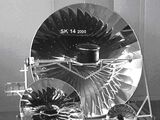
SK14 -
Collapsible Parabolic Cooker -
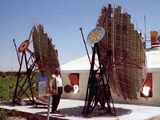
Scheffler Community Kitchen -
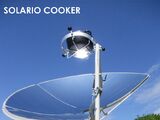
Solario Cooker -
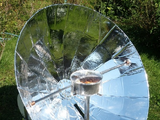
Hypar Solar Cooker -

Solar Wok -
SUNplicity Solar Cooker -
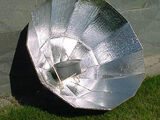
Double-Angled-Twelve-Sided cooker
All items (123)
- Papasan Chair Solar Cooker
- Papillon
- Parabolic solar concentrator for industrial heating
-
Parabolic solar cooker designs
- Parabolic Solar Cooker LD-150
- Parabolic solar cooker with circular tilting feature
- Parabolic Star Grill
- Parabolical Ground Cooker
- Paracocina
- Parvati Solar Cooker
- Pasly Solar Cooker
- Portable Solar Barbeque
- Premium11
- Premium14
- PRINCE-40
- Promethee
- Proyecto Disco Solar
- Satellite dish
- Scheffler Community Kitchen
- Scheffler2qm
- SK1.4
- SK12
- SK14
- Solar - Concentrator
- Solar 1000
- Solar Barbeque (Solar Brother)
-
Solar Bowl
-
Solar Burner
- Solar Design T-Square
- Solar Ibex
- Solar Injera Cooker
-
Solar Oven Cart
- Solar Umbrella Cooker
- Solar Water Boiler
- Solar Water Lens
- Solar Wok
- SolarCooker Eco3
- Solario Cooker
- Solario Safe
- SolarShuttle
- SolReka Parabolic Solar Oven
- SolSource Sport
- Star Flower
- Sun Blaze BBQ
- Sun Juicer
- Sunbrella
- SunFire 14
- Sunflower Solar Cooker
- SuniCook
- SUNplicity Solar Cooker































